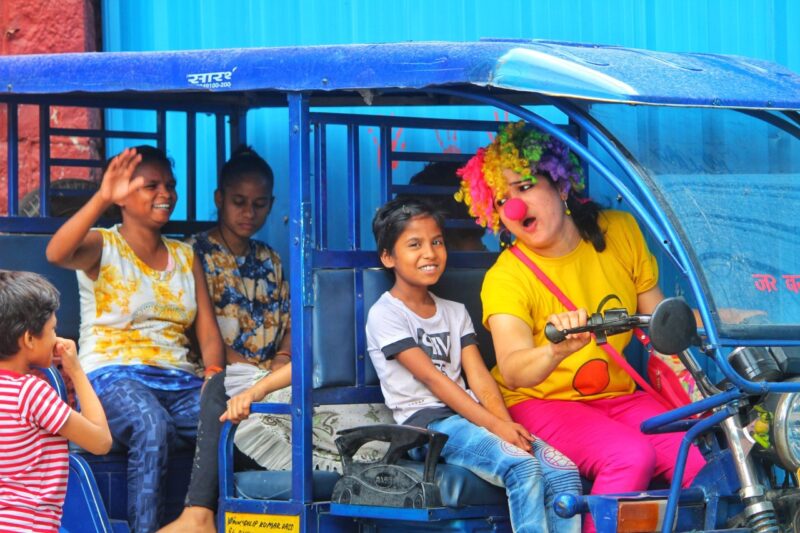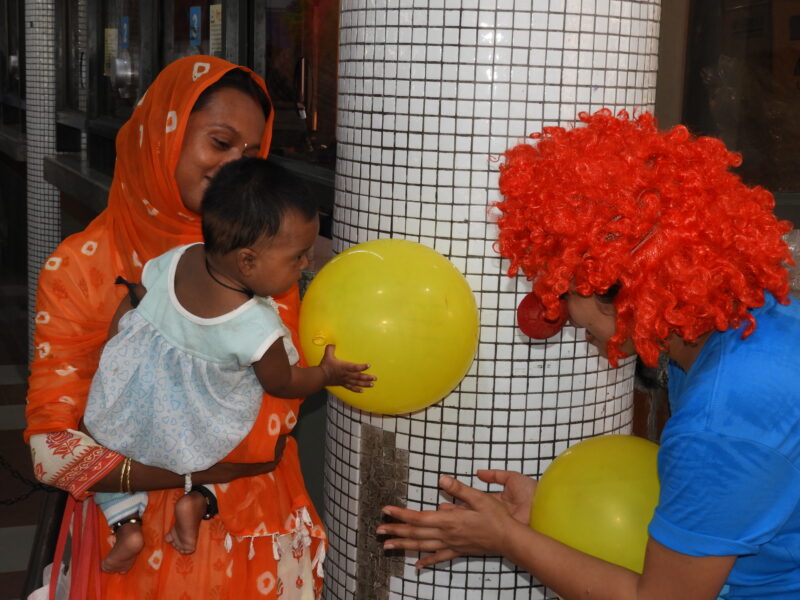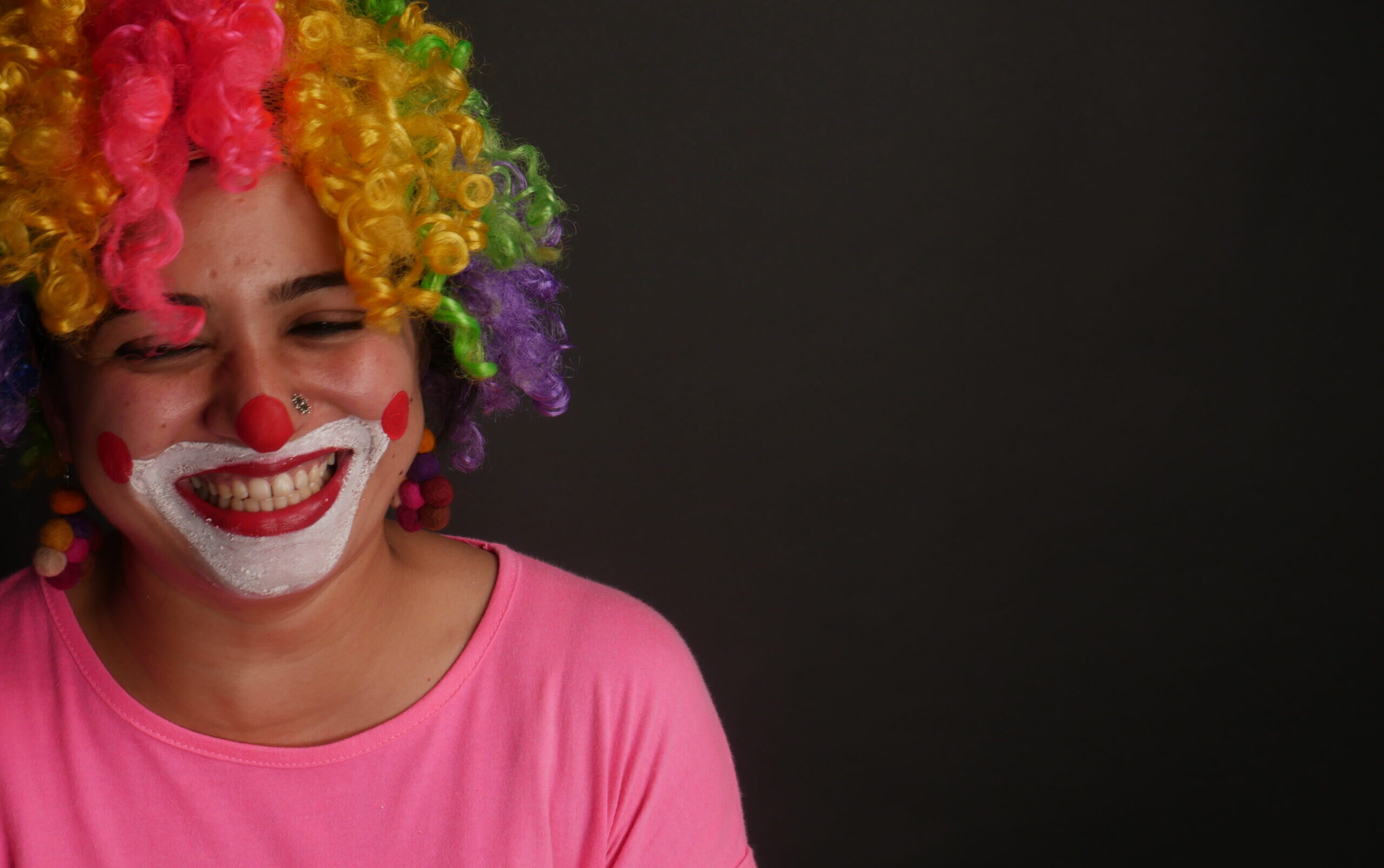People wearing large wigs, coloured faces and big red noses walking around engaging in silly antics – yes, they are clowns. But these clowns are wandering around hospital wards spreading smiles as a form of therapy: to cheer the patients and make them feel good.
Medical clowning is a form of therapy in which clowns visit hospitals and help lift the patient’s mood with humour and silly acts. It is believed that Hunter Patch Adams – an American physician, comedian, and social activist – introduced this technique when he was working in a hospital in the United States. He realised that the whole medical system focuses on physical health while less attention is given to their mental condition.
Adams started doing silly acts using props available around him in the hospital. These acts started to show positive impacts on patients – even the aggressive ones.
Sheetal Agarwal, founder of Delhi-based volunteer group Clownselors, engages in medical clowning regulalry. It’s a typical day in her life — dressing up, performing in hospital wards, singing songs and spreading infectious smiles to everyone. In this conversation with Patriot, she talks about how she formed the group, its growth and the feedback it has received so far.
How it began
Agarwal was attending a retreat in Ahmedabad in January 2016, where she met Dhara, who introduced herself as a medical clown from Baroda. Until then, her idea of clowns was the same as everyone — those who perform in circuses.
The term medical clown intrigued her, and after the retreat, she started looking it up on the net. Though there wasn’t much visual content available, she did find research material and watch the movie Patch Adams starring Robert Williams. The 1998 movie is based on Hunter Patch Adams life and his journey with medical clowning.
Agarwal was fascinated by the thought of sharing a smile with somebody in a vulnerable space. She wondered it’d be nice to go in with a smile and avoid talking about the disease at all.
“Smiling is something that is always powerful, and it was always my descent. I couldn’t handle too many people and it would get really uncomfortable. Every time when people used to talk to me or if I was at a large gathering, I’d keep smiling. But to use something like this…I really wanted to try this”, said Agarwal.
Soon, she contacted Dhara and got to know that Delhi had not yet woken up to the concept of medical clowning. Later, Agarwal posted on Facebook asking how many people will be interested in doing this cause. She received 33 responses. The next step was to seek permission from the Delhi health ministry.
“After a series of meetings on 9 July 2016, we decided to have the pilot run at Chacha Nehru Bal Chikitsalaya. Out of the 33 responses we received, five people turned up. The person who was supposed to train us couldn’t show up as he was busy”, Agarwal says.
Among the five, they had a chief performer who showed them little tricks, and they entered the out-patient department (OPD) making a train and singing the popular children’s song Lakdi ki kathi. People were curious, and they could feel the atmosphere changing.
“After five hours of clowning in both out-patient and in-patient departments, we realised we could make a difference. Some children who had refused their food started eating when we played with them. There were parents who started crying because it had been so long since they saw their child smile.”
The volunteers too felt different inside. “A lot of stress was going away. It was definitely a two-way process”, she adds.
For the first three months, clowning was scheduled only for alternate Saturdays. Later, they expanded it to every Saturday.
Speaking about how medical clowning has affected her, Ekta, who has volunteered with Clownselors since the first day, says, “I have been clowning because it gives me a feeling of contentment. I become ‘hungover’ with smiles at times and it helps me feel happy for the next week or till the next clowning. Also, it has been helpful for the medical staff. They said they need us to overcome some painful moments.”

Growth of Clownselors
By December 2016, the group had its first media coverage by Better India, and soon, more volunteers started joining the circle. They soon expanded their performance to old age homes and orphanages. Though the term sounds ‘medical’, the process was more about caring and being empathetic.
After two years, other Delhi Government hospitals approached them, expanding the group’s reach beyond paediatric centres. Agrawal did a counselling course as the activity includes a lot of counselling.
“I found a lot of competition and I realised people in India were not encouraging. Every time I spoke to some clown, they would tell me what all is wrong with us. But they didn’t tell us how to improve”, says Agarwal. She got in touch with clowns from Israel, Australia and US who advised her to focus on their strong point and use it to the maximum.
Clownselors is a voluntary group and doesn’t charge from any place. “We heard from some hospitals that till the time you don’t charge, you won’t get the value you deserve. We didn’t think about it because all of us had a job”, she says.
Then, in November 2018, Agarwal quit her job and took to clowning full time. A year later, when Apollo Hospital contacted them for paediatric oncology, they decided to charge for invited events from private organisations, but continued to work free at government hospitals and other vulnerable spaces. Before the pandemic they had two extended contracts from Apollo and Kalawati Saran Children’s Hospital. Due to Covid-19 they haven’t been able to go back until now.
While talking about how organisations approach them to schedule events, Agarwal says, “It works both ways. There are times when hospitals contact us. We were contacted recently by Fortis Healthcare, Gurgaon. They contact us for special occasions to do awareness activities. We are also connecting with hospitals, now that we are trying to expand to other states.”
Simran, a BBA student, volunteers with Clownselors. For her, it’s all about doing something good for society. “The visits we do to NGOs and events are so heartwarming. They teach us so many things about life, how you have to adjust with people around you and be grateful to God for whatever he has given you. During the clowning session, I am a different person altogether, and for that duration of time, I forget everything else and focus on my emotions. It has made me a better person, where I feel and respect every emotion of others”, she says.
The volunteers are planning to make clowning a regular gig at hospitals. There are cases where patients’ condition have improved, which gives hope about a complete recovery. The group is also planning to get long-term contracts for better results.
Support system
Agarwal’s family was supportive of her volunteer work, but there was a mixed bag of opinions when she decided to go full-time. Her mother has clowned with them on a few occasions. “There was support, and there was this suggestion to do it as a hobby, to not invest too much time and energy into this”, she says. Gradually, the confidence and support from people grew. When her friends saw how passionate she was, they supported her. Some of her friends donated money when she quit her job.
Different methods
“Clowning changes from person to person. It has a lot of layers”, says Agarwal. In Europe, clowns don’t speak casually with their attire on, and in the US, there is a lot of stand-up comedy that goes along with it. In India, it is usually music and silly acts that go well. The taste in music changes in different parts of the country.
“A lot of times, hospitals ask us to wear wigs because that will appear more appealing and attractive, and also makes our jobs easier because when we look different and colourful, people anyway get amused and attracted to us. If it is an awareness,campaign, we include performance and engagement which is a planned activity. If we are going to wards, there are repetitive acts which we know will work with everybody. And there are also spontaneous acts”, she says.
Speaking about how the acts change according to needs, Agarwal says, “If we know that the person or child is suffering from lung cancer, then we would try more balloon acts with them. We will let them blow the balloons so it helps them exercise. It’s the same for heart patients. If there is somebody who needs to move their body and is not able to move it — like if they have a fracture and need exercise — then we will try to include acts which have a little more exercise, but does not seem like exercising”.

‘Pandemic couldn’t stop us’
Even during the pandemic, Agarwal and her team tried to perform clowning. She felt that it was the most needed during that period. “People were afraid of being alone, and many died — not because of Covid, but because of the fear of isolation”, said Agarwal.
Though many hospitals didn’t allow it due to protocols, they started clowning in migrant centres to cheer them up, as people were stuck here unable to go home.
During the second wave in April 2021, Clownselors were invited by the Meghalayan government to train people and start clowning there. They went to three hospitals; at Neigrihms, a centrally run hospital, they were allowed in the Covid-19 ward to spread their infectious smiles.
“There was this man who had no guardians around him and danced with us. Another woman said she will start coughing but she could not stop laughing. These were the small things that we keep close to our heart”, she says.
“There was a patient from Meghalaya who was in a lot of pain. When he smiled, the wife could not hold back and kept telling us that her husband was smiling. The daughter messaged us after a few months that he is no longer with us, but his smile is. We hold that close to us. This is a big validation for us”, concludes Agarwal.
For more stories that cover the ongoings of Delhi NCR, follow us on:
Instagram: https://www.instagram.com/thepatriot_in/
Twitter: https://twitter.com/Patriot_Delhi
Facebook: https://www.facebook.com/Thepatriotnewsindia





